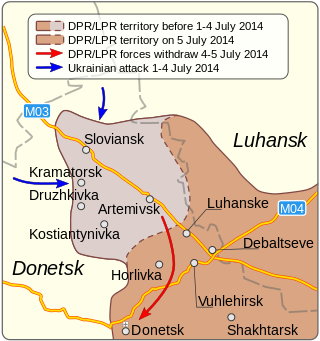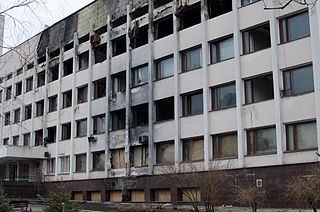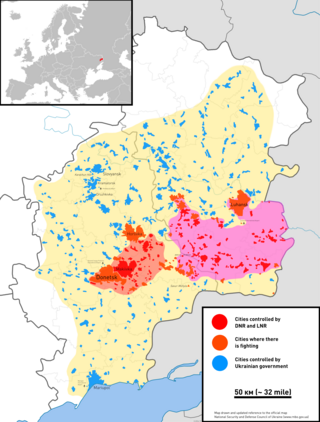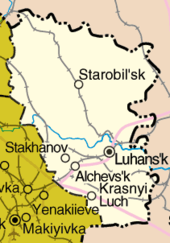
The State Border Guard Service of Ukraine is the border guard of Ukraine. It is an independent law enforcement agency, organized by the Constitution of Ukraine as a military formation, the head of which is subordinated to the President of Ukraine.

Popasna is a city in Sievierodonetsk Raion, Luhansk Oblast, Ukraine. It is the administrative center of Popasna urban hromada, one of the hromadas of Ukraine. In 2018, it was estimated that it had a population of 20,600 people.

From the end of February 2014, in the aftermath of the Euromaidan and the Revolution of Dignity, which resulted in the ousting of Russian-leaning Ukrainian President Viktor Yanukovych, demonstrations by Russian-backed, pro-Russian, and anti-government groups took place in major cities across the eastern and southern regions of Ukraine. The unrest, which was supported by Russian military and intelligence, belongs to the early stages of the Russo-Ukrainian War.
The following lists events that happened in 2014 in Russia.

Russian separatist forces in Ukraine, primarily the People's Militias of the Donetsk People's Republic (DPR) and the Luhansk People's Republic (LPR), were pro-Russian paramilitaries in the Donbas region of eastern Ukraine. They were under the overall control of the Russian Federation. They were also referred to as Russian proxy forces. They were active during the war in Donbas (2014–2022), the first stage of the Russo-Ukrainian War. They then supported the Russian Armed Forces against the Ukrainian Armed Forces during the 2022 Russian invasion. In September 2022, Russia annexed the DPR and LPR, and began integrating the paramilitaries into its armed forces. They are designated as terrorist groups by the government of Ukraine.

The siege of Sloviansk was conducted by Ukraine between 12 April 2014 and 5 July 2014. It began immediately after Sloviansk was seized by the separatist group, the Donetsk People's Republic, which, having received support from Russia, declared itself independent from Ukraine on 7 April. Following three months of heavy fighting between the Armed Forces of Ukraine and the DPR People's Militia, the Ukrainian government retook the city as the pro-Russia rebels retreated to Donetsk. The engagement in Sloviansk marked the first military engagement of the War in Donbas.

The war in Donbas, or Donbas war, was a phase of the Russo-Ukrainian War in the Donbas region of Ukraine. The war began in April 2014, when a commando unit headed by Russian citizen Igor Girkin seized Sloviansk in Donetsk oblast. The Ukrainian military launched an operation against them. The war continued until subsumed by the Russian invasion of Ukraine in 2022.

The Luhansk People's Republic or Lugansk People's Republic is an internationally unrecognized so-called republic of Russia in the occupied parts of eastern Ukraine's Luhansk Oblast, with its capital in Luhansk. The LPR was proclaimed by Russian-backed paramilitaries in 2014, and it initially operated as a breakaway state until it was annexed by Russia in 2022. The entire territory of LPR is viewed as sovereign territory of Ukraine by nearly all UN member states.

A series of armed skirmishes and confrontations between the Armed Forces of Ukraine and pro-Russian separatists affiliated with the Donetsk People's Republic took place from 12 April until 5 July 2014, and is known as the Battle of Kramatorsk.

During the 2014 pro-Russian unrest in Ukraine in the aftermath of the Revolution of Dignity, the city of Mariupol, in Donetsk Oblast, saw skirmishes break out between Ukrainian government forces, local police, and separatist militants affiliated with the Donetsk People's Republic. Government forces withdrew from Mariupol on 9 May 2014 after heavy fighting left the city's police headquarters gutted by fire. These forces maintained checkpoints outside the city. Intervention by Metinvest steelworkers on 15 May 2014 led to the removal of barricades from the city centre, and the resumption of patrols by local police. Separatists continued to operate a headquarters in another part of the city until their positions were overrun in a government offensive on 13 June 2014.

The First Battle of Donetsk Airport took place between fighters associated with the Donetsk People's Republic and Ukrainian government forces that took place at Donetsk International Airport on 26–27 May 2014, as part of the war in Donbas that began after the 2014 Ukrainian revolution. A second battle broke out at the airport on 28 September 2014.

The Battle in Shakhtarsk Raion began on 16 July 2014, when the Armed Forces of Ukraine attempted to cut off the Russian backed separatists’ supply lines from Russia. Fighting broke out around the towns of Marynivka, Dmytrivka, Stepanivka, Shakhtarsk, as well as the strategic hill of Savur-Mohyla. It later spread to the cities of Snizhne and Torez. While the battle was in progress, a civilian passenger airliner, Malaysia Airlines Flight 17, was shot down near Hrabove on 17 July. Amidst a wide counter-offensive by the Russian proxy forces and their Russian backers across Donbas, government troops were forced out of Shakhtarsk Raion on 26 August.
On 18 August 2014, during the war in Donbas, a convoy of refugees fleeing heavy fighting near Luhansk, Ukraine, was hit by an artillery strike. At least 17 people were killed in the strike which the Ukrainian government blamed on insurgents affiliated with the Luhansk People's Republic. The insurgents denied striking any convoy and blamed the attack on the Ukrainian government.

During the ongoing Russo-Ukrainian War between the Ukrainian government forces and pro-Russian separatists in the Donbas region of Ukraine that began in April 2014, many international organisations and states noted a deteriorating humanitarian situation in the conflict zone.

The Battle of Debaltseve was a military confrontation in the city of Debaltseve, Donetsk Oblast, between the pro-Russian separatist forces of the Donetsk People's Republic (DPR) and Luhansk People's Republic (LPR), and the Ukrainian Armed Forces, starting in mid-January 2015 during the war in the Donbas region. The Russian forces composed mostly of "Wagner Group" soldiers recaptured Debaltseve, which had been under Ukrainian control since a counter-offensive by government forces in July 2014. The city lay in a "wedge" of Ukrainian-held territory bordered by the DPR on one side, and the LPR on the other, and is a vital road and railway junction.
The Zelenopillia rocket attack took place on 11 July 2014 during the war in Donbas. The rocket barrage, which was launched from inside Russian territory by Russian forces, killed 37 Ukrainian soldiers and border guards in a camp at Zelenopillia, Luhansk Oblast.

This is a timeline of the war in Donbas for the year 2014.

This is a timeline of the war in Donbas for the year 2015.

This is a timeline of the war in Donbas for the year 2016.
The combatants of the war in Donbas included foreign and domestic forces.














